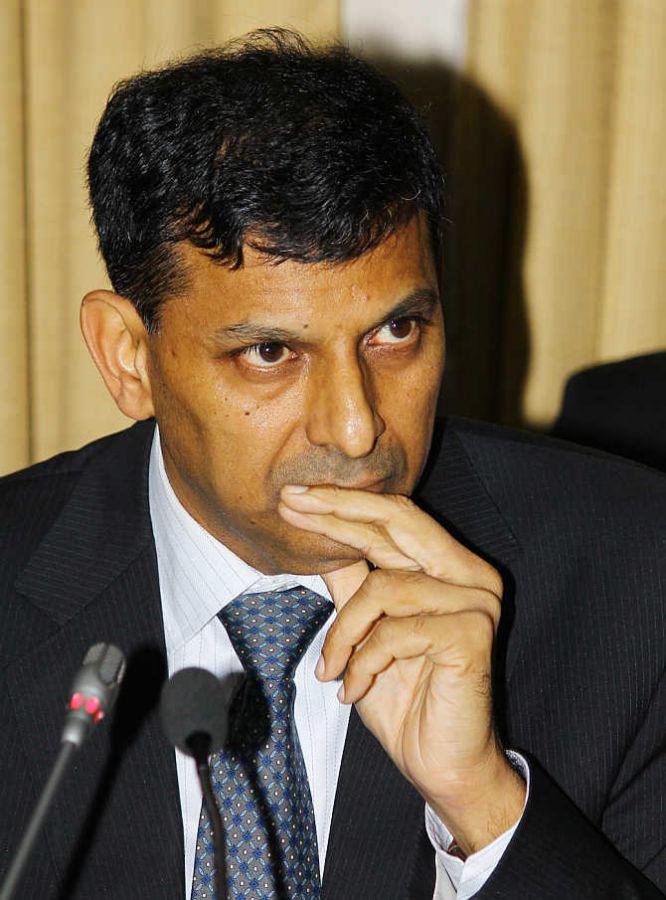
'Most emerging market central banks have uncompensated CRR, and it typically varies between four per cent and 15 per cent.'
'The battle on inflation is never won.'
'I will not cut deposit rates but will raise rates in some maturities to attract more money.'
Reserve Bank of India Governor Raghuram Rajan, in his post-policy interaction with select print media representatives, said the central bank was fighting for its credibility that once a stance is taken, it should not be abandoned.
He acknowledged the earlier stance of infusing short-term liquidity, expecting it to take care of longer term liquidity needs, did not go down well with banks.
Excerpts:
If liquidity is the issue, why was the cash reserve ratio not cut?
CRR is pretty low by our statutory requirements, where the minimum is three per cent.
Most emerging market central banks have uncompensated CRR, and it typically varies between four per cent and 15 per cent.
So, we are at the lower end of that scale.
Given that we have one per cent CRR in excess of statutory requirement, it doesn’t seem the most compelling instrument.
Why did you not go for a 50 bps rate cut?
We have been steadily cutting rates as we see the room emerge in the economic environment.
And, our sense is that the 25 bps cut is justified. We want to reduce uncertainty.
But, we need to have a better sense of what are the uncertainties surrounding the economy before we take further action.
More importantly, we had to see the past rate cuts should pass through.
Do you have a rupee level in mind?
Foreign exchange operation follows the rule that we want to minimise unnecessary volatility, but we’re not trying to pick a level for the rupee.
You said RBI is prepared for outflow of foreign currency non-resident (bank) deposits. Are banks prepared?
The logic here is, if I have taken a deposit from somebody, I have probably lent to someone else.
If I was doing arbitrage trade that many of these people were doing, it would be a liquid asset to allow me to capture the interest arbitrage.
Banks were essentially giving people a better deal than what we were giving because of the added swap element.
But, when the FCNR(B) deposits mature, there would be shortage of liquidity. . .
There could be inflows equivalent to the outflows.
There could be higher interest rates in the system to attract flows temporarily or new flows will come in.
For a day or two, banks might say okay, I need to attract higher deposits to replenish deposits that have flown outside.
I will not cut deposit rates but will raise rates in some maturities to attract more money.
Alternatively, this money that was in an FCNR(B) deposit has been lent to someone who wanted foreign exchange loans.
Now, when you have to repay FCNR(B), he says ‘I have to repay the loan, so let me go and borrow ECB (external commercial borrowing)’.
He borrows ECB, repays the loan to the bank that goes to pay the FCNR (B) deposit.
So, overall, I don’t think there would be a liquidity crisis.
Does the change in your liquidity stance imply that the market and the banks were right in demanding longer-term liquidity measures?
Theoretically, there was no reason for banks to complain about lack of liquidity because we were supplying it at relevant rates.
Banks represented to us that they felt different when they came in the morning with a liquidity deficit rather than a liquidity surplus.
There seems to be some tightness in the market increasing after January.
Given that we had the instruments to move from deficit to neutral and given the compelling reason for staying in deficit was no longer there, I would not say there is strong theoretical or empirical evidence one way or another.
There was a mild empirical evidence that we looked at, combined with the sense that we want to move away from an idiosyncratic framework over time to something which is more consistent with monetary policies around the world.
The Economic Survey said RBI should use its capital to recapitalise banks. . .
Whoever wrote that piece does not understand monetary policy and monetary balance sheets as well as they should.
There is an equity position that the RBI has.
Think of this as government assets in RBI.
The government’s liabilities are its debt. What is being suggested is that we actually monetise this amount.
If we have X number of crores by which we can monetise our assets, if we give half of that to the government, the residual value of it is always spent on buying government bonds.
What we are saying is, given those constraints, any money given extra to the government will reduce our ability to buying government bonds directly and will have absolutely no effect on the public sector borrowing requirements.
The government will have to find some other place to sell its assets.
It is not a free asset to be given.
We are saying ‘treat it as a government asset’. It’s not going to impact your borrowing requirement.
Do you see your battle on inflation as won?
The battle on inflation is never won.
It’s always a temporary victory because some other factor comes in.
The battle we are really fighting today is for credibility.
Credibility that at the first sign of trouble, we don’t abandon our policy regime, that we stick to it.
Once we gain the credibility, even if the economy is hit by shocks, you won’t have a significant movement in flows in and out or a significant change in inflation.
We need to build credibility that we will stick to our inflation forecast and not drop it every time in the face of pressure.
If we build that, we will have more room to cut interest rates and to have a low interest rate regime.
The reason we have a high interest rate regime is because we haven’t got as much credibility as we need.
I am encouraged by the fact that for the first time, the Survey results show the nodal inflation now is five to six per cent.
It’s not won yet but if it stays this way for some time, it would suggest we have got more credibility on inflation that we had in the past.
Is asset quality review a one-time exercise?
AQR identified the extent of problem assets and said, ‘Here’s a subset of assets to deal with immediately’ and ‘here’s a subset you could take some more time to deal with’.
But, the point about AQR is more about the change in how banks are supposed to approach this issue. Remember that we had forbearance till April 2015; the forbearance is done and gone.
The idea is to recognise as soon as it needs to be recognised. That attitudinal change across the system is also what we hope to embed through the AQR process.
The annual financial inspection will go on. But, this examination of assets is something we want to do at least once to make sure the system is well identified.
Going forward, I don’t see an immediate need to do it again. But I am not going to dispense with this tool and say we’ll never need it again.
Is the Pay Commission outflow factored in for inflation?
We don’t know how much the Pay Commission outflow will be.
It is factored in for the fiscal deficit, but to the extent of specific elements such as the house rent allowance component of inflation, which has a mechanic effect, though it won’t influence inflation in the long run.
This will elevate inflation and that’s where the 100 basis points or so increase came from.
That’s something we need to watch carefully.
Image: Raghuram Rajan. Photograph: Hitesh Harisinghani/Rediff.com










